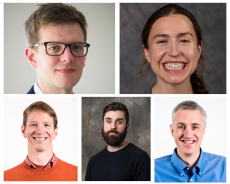NERSC Quantum Team Wins Prestigious Hans Meuer Award
March 26, 2024
By Elizabeth Ball
Contact: cscomms@lbl.gov

The team of (clockwise from upper left) Daan Camps, Katie Klymko, Nick Wright, Ermal Rrapaj, and Brian Austin has been awarded the Hans Meuer Award for best paper submitted to the ISC High Performance computing conference.
A team studying quantum computing at Lawrence Berkeley National Laboratory (Berkeley Lab) has been awarded the prestigious Hans Meuer Award, which annually recognizes the most outstanding paper submitted to the ISC High Performance computing conference in Hamburg, Germany. This year, ISC introduced a new research paper track on quantum computing, and the team of Daan Camps, Ermal Rrapaj, Katherine Klymko, Brian Austin, and Nick Wright, all based at the National Energy Research Scientific Computing Center (NERSC) at Berkeley Lab, will be the first recipients of the Meuer Award from the new track.
The winning paper, “Evaluation of the classical hardware requirements for large-scale quantum computations," is part of an effort to gain an improved understanding of what technology will be required to one day integrate a large-scale quantum computer with a classical supercomputer, augmenting the capabilities of the HPC system in such a way that it supports the quantum system in solving problems the HPC system alone could not.
“In our work we focused on modeling the classical workload required for real-time decoding of fault-tolerant quantum computations, as this is generally expected to be required to scale up quantum computers and relies heavily on classical data processing,” said Camps, a staff member in the NERSC Advanced Technologies Group and lead author on the paper.
In the paper, the team proposes a new model to evaluate the classical computing and networking resources required to support a large-scale fault-tolerant quantum computer based on superconducting qubits and a surface code architecture. The team focused on quantum error decoding, which is the primary classical computational task required to enable fault tolerance during runtime.
The results of their analysis show that error correction can be enabled for a quantum computer with 2,000 logical qubits with two petaflops of computational power. This is a promising result and it shows that a substantial HPC resource will not be needed for an error-corrected quantum computer. Furthermore, their model indicates that current networking technology can also meet the bandwidth and latency requirements to support large-scale quantum computation. However, there are still significant technological challenges for both quantum and classical hardware to overcome before these integrated systems can be developed.
Simulations run on NERSC’s Perlmutter supercomputer yielded data that played a key role in strengthening the model described in the paper. “Our work is based on an abstract model, informed by the most recent literature, of what a fault tolerant quantum computer could look like. We enhanced this model with simulation data obtained from NERSC’s Perlmutter system to get to our final estimates,” Rrapaj said.
Long-term, the team is focused on accelerating computational research through improved quantum algorithms and hardware. This includes access to near-term quantum hardware to codesign algorithms with hardware advances, classical software development and HPC deployment to simulate quantum systems at scale, and providing users access to state-of-the-art classical (and eventually quantum) hardware and software to study quantum systems. Additional work focuses on how quantum technologies will eventually integrate with classical supercomputers, which was the focus of this project.
Moving forward, the team will observe the progress of quantum computing and where their work fits in. “It will be exciting to see how the quantum computing stack continues to evolve in the future towards larger and larger systems that are starting to implement some preliminary versions of error-corrected computations and see if our estimates will stand the test of time,” said Wright, Chief Architect at NERSC and another author on the paper.
But for now, the team is proud to accept their award. “We are honored to win the Hans Meuer Award and get this recognition for the quantum computing work we are doing at NERSC, especially since this is the first year ISC has included a quantum computing track for their research papers,” said Camps. “We are looking forward to presenting the results of our study at the ISC 2024 conference in May.”
The Research Paper Award Session will be held at ISC 2024 in Hall 4 on Monday, May 13, from 4:15 p.m. to 5:00 p.m. CET (GMT +1)
About NERSC and Berkeley Lab
The National Energy Research Scientific Computing Center (NERSC) is a U.S. Department of Energy Office of Science User Facility that serves as the primary high performance computing center for scientific research sponsored by the Office of Science. Located at Lawrence Berkeley National Laboratory, NERSC serves almost 10,000 scientists at national laboratories and universities researching a wide range of problems in climate, fusion energy, materials science, physics, chemistry, computational biology, and other disciplines. Berkeley Lab is a DOE national laboratory located in Berkeley, California. It conducts unclassified scientific research and is managed by the University of California for the U.S. Department of Energy. »Learn more about computing sciences at Berkeley Lab.







